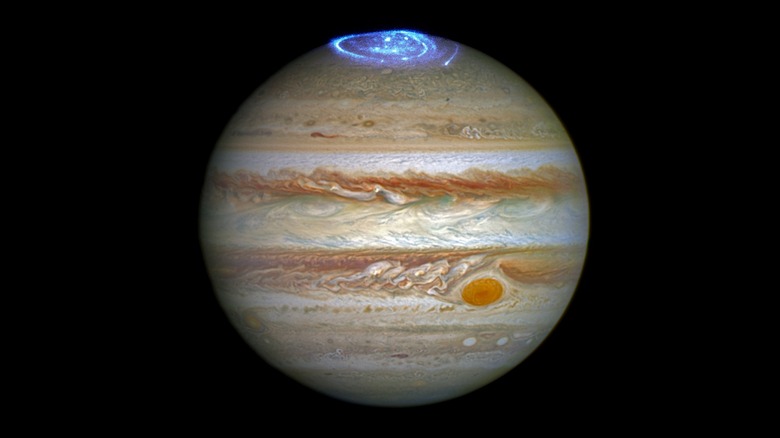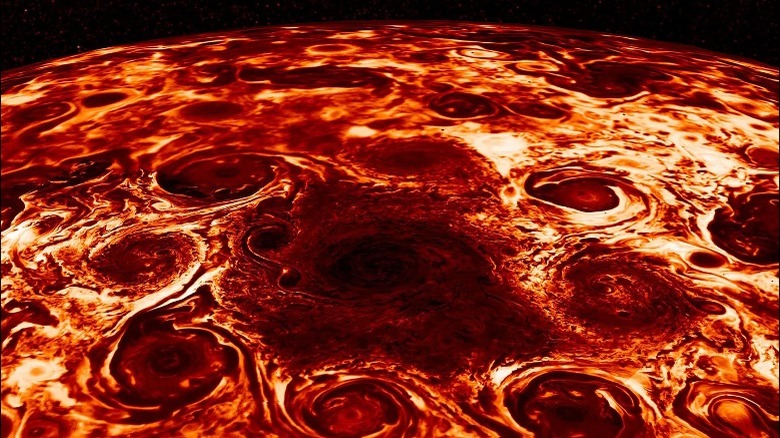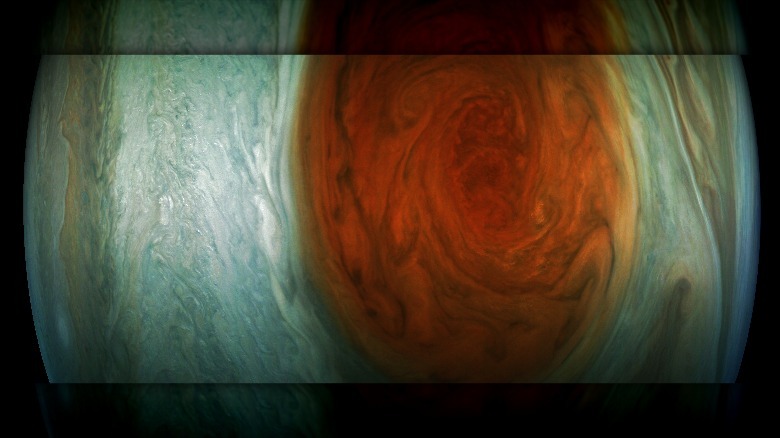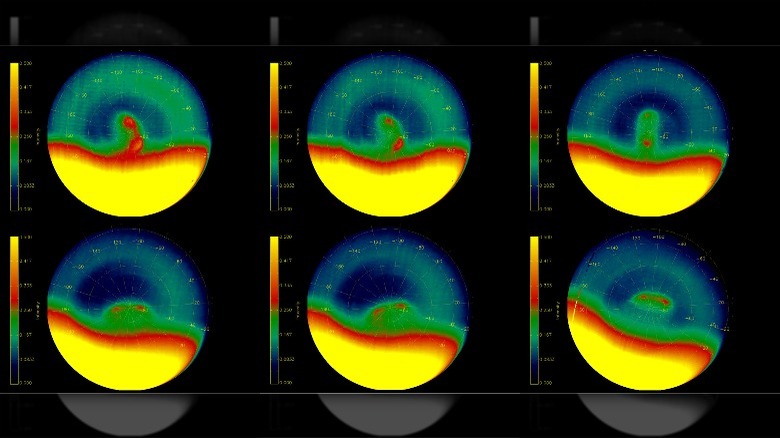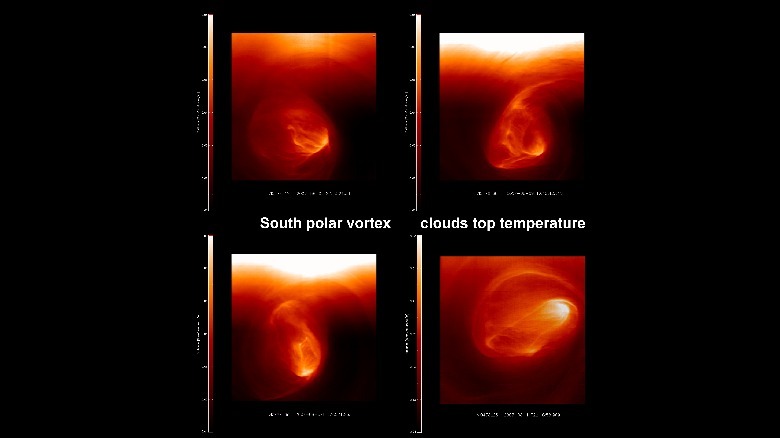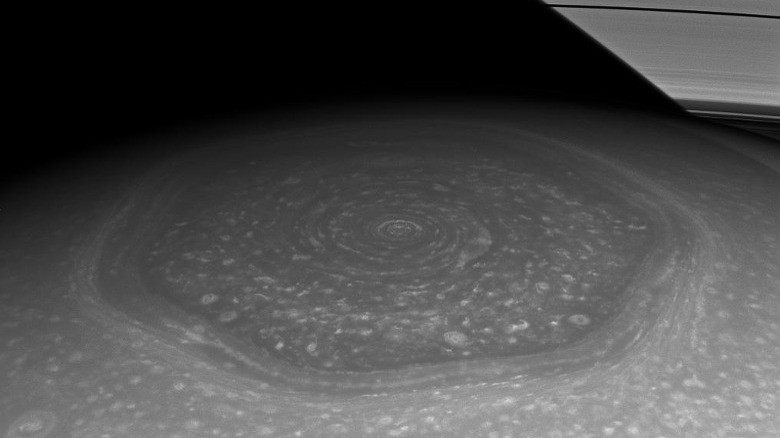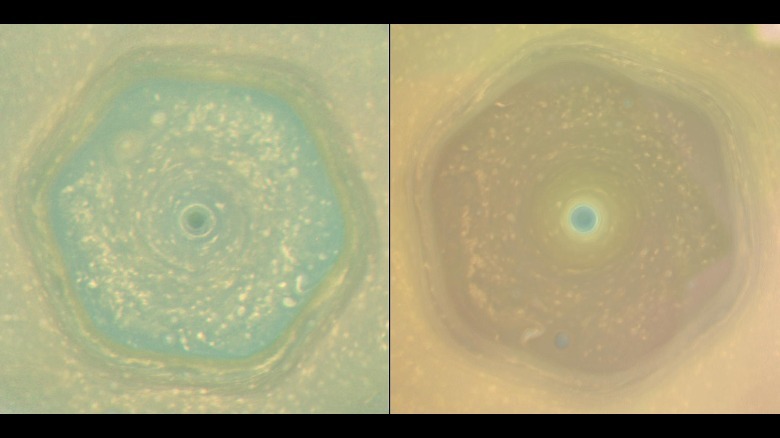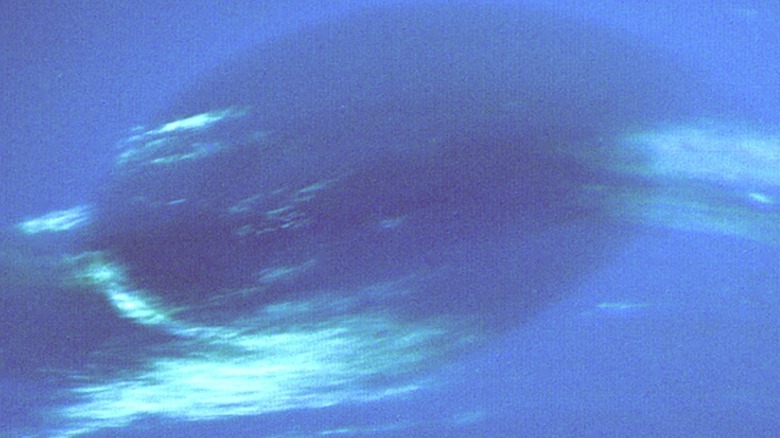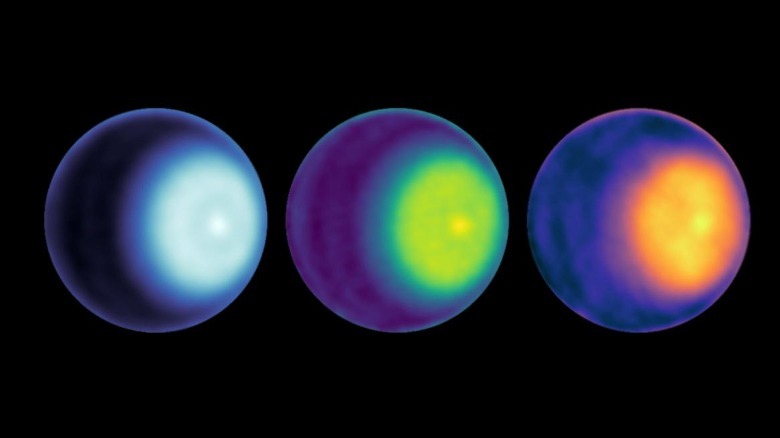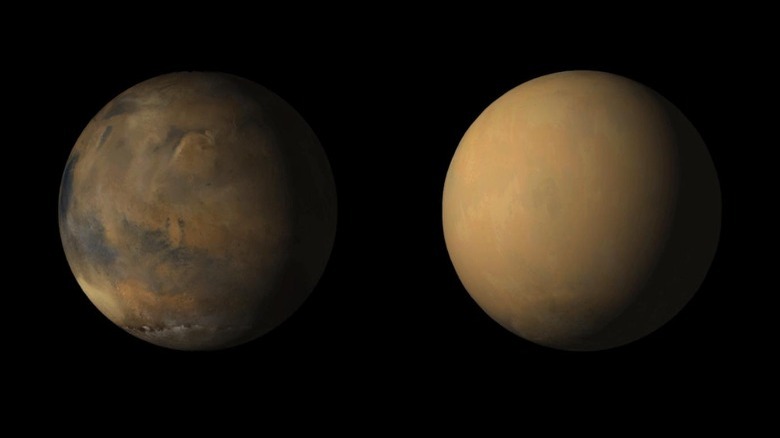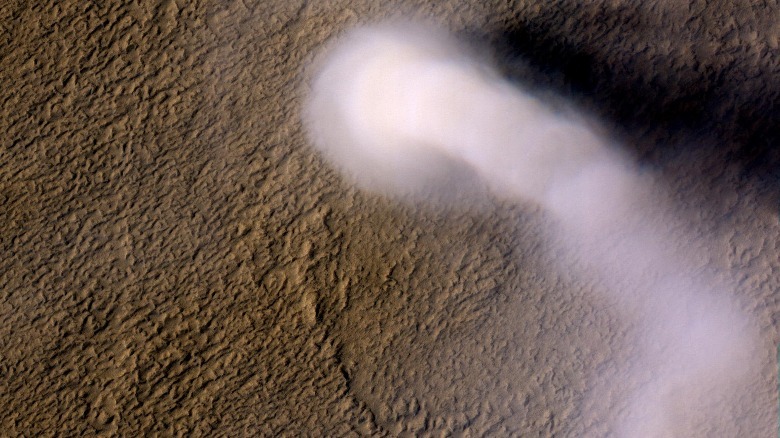Six Planets That Have Unimaginable Storms Compared To Earth
The Earth is the only cradle of life we know of. Through its billions of years of existence, it's seen some seriously bad weather, from billions of lightning strikes a year to planet-wide ash and dust clouds from volcano eruptions and meteor impacts. But all that is almost nothing compared to the daily lives of other planets in our solar system — take the Great Red Spot for example, an unimaginably massive storm system on Jupiter that's been larger than three times the size of our planet.
Apart from Jupiter, which has plenty of other planet-sized storms, our solar system has a continent-sized double vortex on Venus, supersonic winds on Neptune, and more incredible weather across six planets of our solar system — barring our very own Earth and the atmosphere-less Mercury. For our viewing pleasure, a lot of this extra-terrestrial extreme weather has been captured in stunning detail by space probes and in the case of Mars, even rovers.
Of course, one could argue it is precisely for its relatively calm weather and stable atmosphere that the Earth has supported complex life for billions of years. It is for this reason that the planet is said to be situated in a Goldilocks or habitable zone in its distance from our Sun. Not too hot, not too cold — just right — allowing water to remain a liquid.
Jupiter
The largest planet in our solar system, Jupiter is a massive gas giant with an equatorial circumference of 272,946 miles. That means it's 11 times bigger than Earth, and in terms of mass, it's 318 times as massive. An important factor in its extreme weather is the speed at which the huge planet rotates — it completes a full rotation in 9.8 hours, which is the shortest day in the solar system. Jupiter is an oblate spheroid, and its poles rotate slightly slower than its equator — 28,273 miles per hour. That's nearly 30 times faster than Earth's near pedestrian 1,037 mph.
In part due to this rotational speed, and because Jupiter has no solid surface to slow its winds down, the planet is enveloped in jet streams – something we can visibly appreciate in the dark and bright bands, belts, spots, swirls, and zones seen across the planet. At the equator, prevailing wind speeds can reach as high as 335 mph, and nearly 900 mph in the upper atmosphere. The planet is filled with cyclones and anti-cyclones, counter-rotating weather systems that even appear in polygonal arrangements near the poles.
One such anti-cyclone is the Great Red Spot (seen above), a gargantuan storm that's been observed for over 300 years. It's huge and has been as large as three Earths with a depth of 300 miles. But Jupiter's Great Red Spot is fading and shrinking. Wind speeds can reach up to 425 mph here. Compare that to the most powerful hurricanes on Earth, with wind speeds up to 200 mph and a diameter of over 1,000 miles. Another massive storm on Jupiter is the Little Red Spot, roughly half the size of the Great Red Spot.
Venus
Venus, a planet named after the Greek and Roman goddess of love and fertility, belies its name. It's the hottest planet in the solar system, and has been described as "Hell". Its atmosphere is thick, with a pressure nearly 90 times that of Earth's sea level at its surface, and made up of mostly carbon dioxide. It has clouds of sulfuric acid, which also happens to be highly reflective — combine that with the thick atmosphere, and only 3 percent of the sunlight the planet receives actually reaches the surface. But in this dark hellscape, the very ground can glow.
The second planet from the Sun, Venus has the highest surface temperature in the solar system, higher than even Mercury. Temperatures can reach over 750 degrees Fahrenheit in some places, hot enough to melt lead and make the ground glow red. The planet rotates very slowly, so slowly in fact, that its day — 243 Earth days — is longer than its year — 225 Earth days. That doesn't mean the planet doesn't have its extreme weather of course.
Venus spins backwards compared other planets. Despite its slow rotation, the planet's winds "super rotate" in the upper atmosphere — circling the entire planet westward in 4 days, at speeds up to 250 miles per hour — faster than an Earth hurricane. Venus, like many planets in the solar system including Earth, features swirling polar vortices akin to hurricanes. However, the over 1200-mile-wide double-eyed southern polar vortex on Venus is different — it's the most unstable and variable. Observations show that the southern polar double vortex is an extremely complex storm with a core shape that can quickly change in less than 24 hours. There's thought to be a similar system at the north pole.
Saturn
Saturn is the second largest planet in the solar system, and because of the gas giant's elaborate ring system and beauty, is often considered the crown jewel. About 9 times wider than Earth with an equatorial diameter of 74,897 miles, Saturn (like Jupiter) rotates very fast — finishing a day in just 10.7 hours. Like Jupiter, Saturn's wind speeds are tremendous, reaching nearly 1,120 mph in the upper atmosphere, far faster than the speed of sound.
The weather systems of Saturn are similar to Jupiter, if not as violent, with the gas giant featuring its own bands, jet streams, cyclones, and anti-cyclones. It too has megastorms, which break out every 20 to 30 years and the storms have a centuries-long impact on Saturn's atmosphere. Saturn's northern polar vortex is a sight to behold, a massive 20,000-mile-wide symmetrical hexagon. According to NASA, the six-sided jet stream is thought to be caused by a "deep supersonic jet stream is pinched on all sides by smaller cyclones and pushed upward, forming the hexagon." Supersonic winds were seen to continue deeper into the atmosphere, 5,000 miles down, at speeds up to 895 miles per hour.
The eye of the central hurricane in Saturn's hexagon is said to be 50 times larger than the largest hurricane eye seen on Earth, while of the multiple cyclones and anti-cyclones that compose the hexagon, the largest vortex (at 2,200 miles) is twice the size of the largest hurricane on Earth. Apart from this, Saturn also has massive lightning storms, recorded by NASA both in image and audio. The planet holds the record for the longest recorded thunder-and-lightning storm in the solar system, lasting 334 days, with lightning up to 10,000 times as powerful as that seen on Earth. Another lasted a total of 267 days.
Ice giants: Uranus & Neptune
The seventh and eighth (and most distant) planets from the Sun, Uranus and Neptune respectively are ice giants. Like gas giants, they have no solid surfaces, and are similar in composition to each other. Their atmospheres are made up mostly of hydrogen and helium, with a little bit of methane (give them their blue hue), and traces of water and ammonia. Both are thought to have small, rocky cores. They are very cold on the outside, with Uranus at -320 degrees Fahrenheit and Neptune at -330 degrees Fahrenheit, but thanks to the pressure, very hot near the cores.
There are also some major differences between the two. Neptune appears to emit more than twice the heat it absorbs from the Sun, similar to the gas giants Jupiter and Saturn, thought to be heat left over from the birth of the solar system. Uranus on the other hand, doesn't have this behavior, and is almost as cold as Neptune despite being closer to the sun and receiving more sunlight. This difference may be because of the much faster winds seen on Neptune, which has the fastest moving winds in the solar system — nearly twice the speed of sound at 1,500 mph, even faster than Saturn. Uranus on the other hand has winds peaking closer to 560 mph.
Many storms have been observed on Neptune, and with a Great Dark Spot as large as Earth first seen back in 1989, and several other dark spots seen after. New storms are thought to crop up every four-to-six years. In recent years, Uranus has been spotted with a large stormy cloud cap on its north pole, and evidence in the past has indicated there is a polar vortex on the south pole as well.
Mars
Mars, the fourth planet from the Sun, is a rocky planet that is a little more than half the Earth's diameter. It has a very thin atmosphere compared to Earth, consisting primarily of carbon dioxide and nitrogen. It rotates once every 24.6 hours, which once you consider its size, isn't very fast – 540 mph, or about half of Earth's rotational speed at the equator. Taking these factors into account, you wouldn't be too wrong if you assumed the planet had very little weather to speak of.
There are global dust storms that occur on Mars however, once every six to eight Earth years. It remains uncertain exactly how these storms come about, but seem to be caused by smaller series of dust storms that create a dust cloud large enough to engulf the entire planet within a matter of days, cutting down surface visibility and obscuring most of the landscape seen from space. It can take months for the after effects of the global dust storm to dissipate. A dust storm in 2018 is thought to have ended Mars' winter early. Apart from these global dust storms, Mars also has dust devils (similar to tornados) that race across its surface periodically. These dust devils can be extremely tall, up to 12 miles high, but just a few hundred feet wide.
